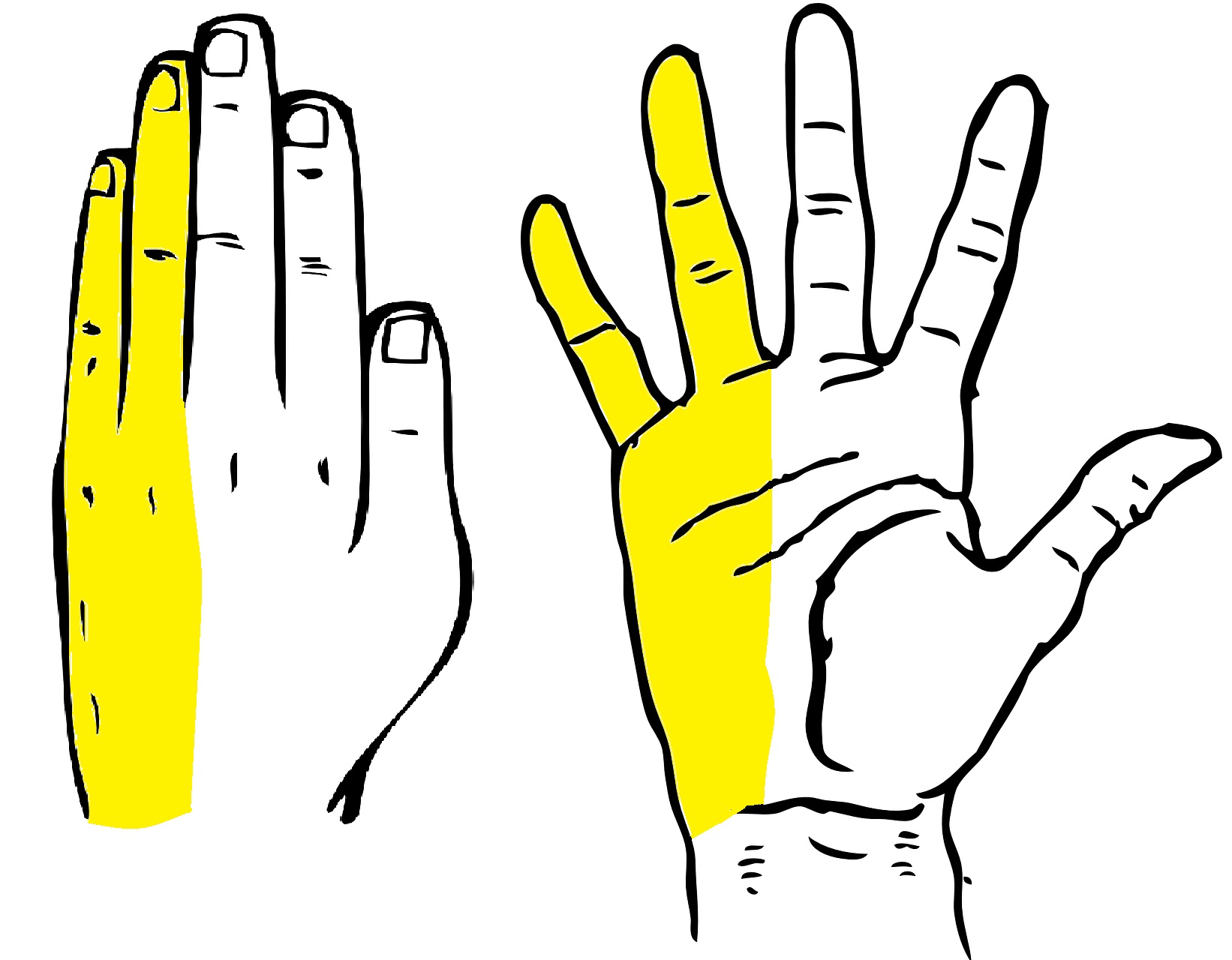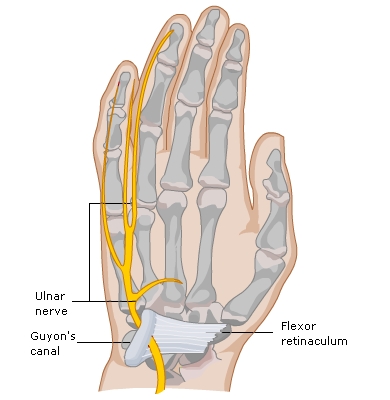Cyclist's palsy
Original Editor - Arno De Maeyer
Top Contributors - Lucinda hampton, Wanda van Niekerk, Evan Thomas, Kim Jackson, Kenneth de Becker, Vanessa Rhule, Scott Buxton, Anas Mohamed, Chrysolite Jyothi Kommu, Admin, Arno De Maeyer, Laura Ritchie, Wendy Walker, Naomi O'Reilly and Claire Knott
Description[1][edit | edit source]
Cyclist’s palsy, also known as ulnar neuropathy or "handlebar palsy", is a familiar affection of the long-distance cyclist. Typically, the ulnar nerve becomes irritated because of the pressure exerted by the hands on the handlebars, particularly when riding on rough terrain. As people cycle, they often have their wrist resting in a hyperextended position on the handlebars or hoods which compresses and stretches the ulnar nerve as it passes from wrist to hand. The symptoms are numbness, tingling, and possibly motor limitation along the course of the ulnar nerve. More often, the superficial sensory branch of the ulnar nerve is affected as opposed to the deep motor branch. Symptoms of ulnar neuropathy can take weeks or months to subside.
Clinically Relevant Anatomy[2][3][edit | edit source]
The ulnar nerve is a branch of the medial cord of the brachial plexus, which travels distally along the medial side of the arm. It passes posteriorly to the medial epicondyle at the elbow, then if follows along the ulna towards the hand. The nerve gives off two sensory branches which supplies sensation to the dorsomedial hand, the 5th digit, and half the 4th digit. At the wrist, the ulnar nerve enters the hand by passing through Guyon’s Canal. This tight tunnel is formed between the hamate, the pisiform, and the pisohamate ligament which helps keep these carpal bones together. Either within or just beyond Guyon's Canal, the ulnar nerve divides again in two motor branches.
In the cyclist, it is at or just before Guyon’s Canal where compressive injury to the ulnar nerve mostly commonly occurs.[4].
Epidemiology/Etiology[2][edit | edit source]
Cyclist Palsy develops during cycling. As mentioned above, the position of the hands while holding the handlebars creates pressure on the ulnar nerve in the canal. The pressure of holding the handlebar in combination with vibrations from the road or trails is enough to injure the nerve, causing a neuropraxia. Even more pressure can occur with cycling downhill as a large part of the body weight is supported by the hands on the corner of the handlebars. Because sensory fibers are not affected, most people are not aware of the compression injury to the nerve until a more severe lesion develops.
Characteristics/Symptoms[1][edit | edit source]
Symptoms can vary from person to person, but they commonly share similarities. Possible symptoms are weakness, numbness, tingling, and possibly motor limitation along the course of the ulnar nerve.
People often report numbness or tingling in the hand that goes away within a day or two, but can have persistent weakness with pinching and fine finger movements.
Differential Diagnosis[2][edit | edit source]
It is important to understand the signs and symptoms of this ailment so that it can be identified and proper diagnosed without having to seek numerous tests.
Assessment of the person's ability to adduct the thumb should be performed. If weakness is apparent, this could be the result of paralysis of adductor pollicis.
Paralysis of the interossei muscles is also possible, and would present as an inability to abduct and adduct all the fingers. To examine, the person places his/her hand on the table and the therapist asks him/her to lift the 3rd finger upwards. The person is then asked to adduct and abduct this finger pertaining to the 4th finger. This is not possible if the person has cyclist’s palsy. In this case, a shift from the flat of the hand and the wrist to the ulnar side would be observed as a compensation.
People withe cyclist’s palsy in advanced stages could have a claw hand, in which case surgery is sometimes indicated.
Diagnostic Procedures[edit | edit source]
After the initial assessment, additional imaging such as ultrasound, CT-scan, and MRI can be performed to help confirm the diagnosis and determine the location of the compression.
Prevention[1][edit | edit source]
Prevention is the most important part to avoid cyclist palsy, and it can be effectively prevented. More in particular, cushioning the pressure points by using padded handlebars and padded cycling gloves is effective. This provides an extra layer of fat tissue inside the palm, so that there is a better shock absorption and protection from pressure. Also the position of the hands on the handlebar is important. Individual adaption of the handlebar and riding position is crucial for prevention of this ailment[5]. The cyclist should regularly change the hand position on bars.
Enthusiastic long-distance cyclists should also adopt a comfortable and resilient riding posture. Because if the trunk gets tired, the hands will invariably bear more weight to stabilize them on their bike. Developing a better posture on the bike requires strong trunk muscle endurance[4].
Treatment[edit | edit source]
This type of nerve injury is self-limiting. So the nerve will regenerate on its own and function of the muscles will be restored. But the symptoms of handlebar palsy can take weeks or months to heal. While the nerve and muscles are regenerating, the patient needs to interrupt his sport activities for a while. A traditional treatment can help the healing. Prevention is important for this type of neuropraxia (see prevention). Also make sure that the cyclist rides on the right size of bicycle and check the position of the handlebars.
References[edit | edit source]
- ↑ 1.0 1.1 1.2 Gloria,C. Cohen, MD, CCFP. Cycling Injuries. Canadian Family Physician, VOL 39, March 1993
- ↑ 2.0 2.1 2.2 Bickerton, T. Handlebar Palsy. Where to Ride. [ONLINE] accessed on 24 September 2010. Available at http://www.wheretoridelondon.co.uk/London-262.html
- ↑ Marieb EN, Wilhelm PB, Mallatt JB. Human Anatomy. 7th ed. San Francisco: Pearson; 2012.
- ↑ 4.0 4.1 Praktijkgids Pols-en handletsels. Meeusen, R. p. 74-77
- ↑ Capitani, D. and Beer, S. Handlebar palsy-a compression syndrome of the deep terminal (motor) branch of the ulnar nerve in biking. Journal of Neurology. 7 May 2002, pag. 1441-1445
- ↑ Specialized Bicycles. Specialized Body Geometry Gloves Available from: https://www.youtube.com/watch?v=EYlU6TBAhlg [last accessed 7/2//2016]








